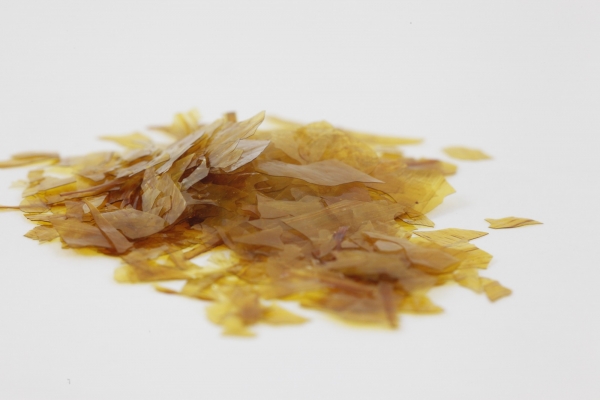
This small amber-coloured mound of fine and fragile flakes is shellac: a natural polymer made by the female lac beetle (Laccifer lacca). Lac beetles are scale insects that are indigenous to the forests of Southeast Asia (mostly India and Thailand). The female lac beetle feeds on the sap of the Palash, Kusum and Indian plum tree, exuding a crusty, chitinous mix of resin and wax in the form of the protective cocoons she creates around her eggs and the twigs she lays them on. This results in something that looks a bit like the crystallised sugar sticks that we sometimes use to sweeten hot drinks. After the newly-hatched lac offspring have left these cocoons, the remnants are harvested and refined to make different grades of shellac, from the most raw seed lac to the most refined button lac, and different colours of shellac from deep red garnet lac to pale blond lac. This often takes the form of dried flakes or buttons that are soaked in alcohol to make a workable, syrupy liquid that can be applied to wood surfaces.
This material is probably most well-known for its use in fine woodworking, where it is used to impart deep, rich colours and create durable, non-toxic and high gloss finishes like French polish. This wood finishing technique has a long history around the world, but is thought to have become particularly popular in Europe in the seventeenth century, when it was used as a clear coating on imported exotic woods like mahogany and satinwood to protect them without covering up their subtle colours and patterns. Hardy nitrocellulose and synthetic furniture polishes largely overtook shellac in popularity in the 1920s and 30s, because of their short-term imperviousness to heat and moisture. However, unlike synthetic polymers, which chemically and irreversibly cross-link when they cure, shellac can be easily repaired by repadding with alcohol or more shellac. This sample of orange shellac was donated by Mimi Sansone, an antique furniture restorer with over twenty years of experience in the restoration and preservation of original patinas and polishes, using traditional methods and materials.
Shellac is less famously responsible for the glossy coating on aluminium foil and paper; the shine in shampoo, hairspray and printing inks; and the food-safe coating on sweets, chocolates and pharmaceutical tablets. This surprising hidden ingredient in our food is often disguised as the additive E904, and is found in the hard shiny shells of chewing gum, jelly beans and milk duds as ‘confectioner’s glaze’, as well as on the surface of some fruits, chocolates and coffee beans. Just like honey from a bee, shellac is not vegan, so it is increasingly being replaced by alternatives like the corn protein zein in foodstuffs. This versatile material also gives its name to a particularly hard, glossy and durable form of nail polish, even though this manicure material often doesn’t actually contain any shellac: the natural, resinous, beetle-derived polish has simply become a by-word for a particularly sleek surface.
Sample ID: 1262
Add materials you find interesting to your own selections.
Use the  button to select a material and get started.
button to select a material and get started.


